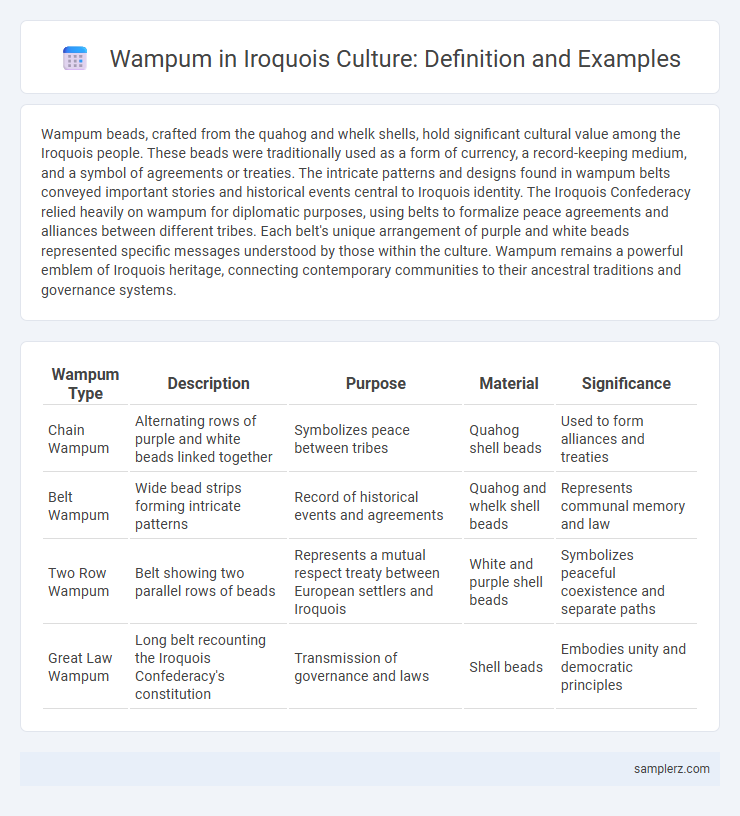Wampum beads, crafted from the quahog and whelk shells, hold significant cultural value among the Iroquois people. These beads were traditionally used as a form of currency, a record-keeping medium, and a symbol of agreements or treaties. The intricate patterns and designs found in wampum belts conveyed important stories and historical events central to Iroquois identity. The Iroquois Confederacy relied heavily on wampum for diplomatic purposes, using belts to formalize peace agreements and alliances between different tribes. Each belt's unique arrangement of purple and white beads represented specific messages understood by those within the culture. Wampum remains a powerful emblem of Iroquois heritage, connecting contemporary communities to their ancestral traditions and governance systems.
Table of Comparison
| Wampum Type | Description | Purpose | Material | Significance |
|---|---|---|---|---|
| Chain Wampum | Alternating rows of purple and white beads linked together | Symbolizes peace between tribes | Quahog shell beads | Used to form alliances and treaties |
| Belt Wampum | Wide bead strips forming intricate patterns | Record of historical events and agreements | Quahog and whelk shell beads | Represents communal memory and law |
| Two Row Wampum | Belt showing two parallel rows of beads | Represents a mutual respect treaty between European settlers and Iroquois | White and purple shell beads | Symbolizes peaceful coexistence and separate paths |
| Great Law Wampum | Long belt recounting the Iroquois Confederacy's constitution | Transmission of governance and laws | Shell beads | Embodies unity and democratic principles |
Historical Significance of Wampum in Iroquois Culture
Wampum belts, crafted from purple and white shell beads, served as crucial diplomatic tools in Iroquois culture, symbolizing treaties, agreements, and historical narratives. These belts encoded laws and conveyed messages across Iroquois Confederacy nations, preserving oral traditions and legal codes. The historical significance of wampum lies in its role as both a communication medium and a sacred artifact reinforcing political unity and social order among the Haudenosaunee people.
Types of Wampum Used by the Iroquois
The Iroquois utilized two primary types of wampum: white and purple beads, each holding distinct cultural significance. White wampum symbolized peace, purity, and goodwill, while purple beads represented war, mourning, and important agreements. Crafted from quahog and whelk shells, wampum belts served as mnemonic devices for treaties, stories, and historical events within Iroquois society.
Wampum as a Medium for Storytelling
Wampum belts served as a vital medium for storytelling among the Iroquois, encoding treaties, historical events, and cultural narratives in intricate bead patterns made from quahog and whelk shells. These belts functioned as mnemonic devices, allowing storytellers to accurately convey complex oral histories and tribal laws across generations. The symbolic arrangement of purple and white beads ensured preservation of communal memory and facilitated the transmission of Iroquois heritage.
Symbolism Embedded in Wampum Patterns
Wampum belts in Iroquois culture serve as powerful symbols, encoding treaties, historical events, and social values through intricate bead patterns. Each color and design sequence carries specific meanings, such as purple beads representing sacredness and white beads symbolizing purity or peace. These patterns function as mnemonic devices, preserving collective memory and reinforcing political and spiritual relationships within the Haudenosaunee Confederacy.
Ceremonial Uses of Wampum Belts
Wampum belts in Iroquois culture served as important ceremonial symbols, representing agreements, treaties, and historical events. These belts, made from polished quahog shell beads, were presented during council meetings to validate decisions and foster unity among tribes. Their intricate patterns conveyed messages and upheld traditions, solidifying social bonds and political alliances within the Iroquois Confederacy.
Wampum in Diplomacy and Treaty-making
Wampum belts played a crucial role in Iroquois diplomacy and treaty-making, serving as tangible records of agreements and alliances between tribes and colonial governments. These belts encoded complex messages through specific patterns and colors, symbolizing shared commitments and peace accords. Their use ensured that verbal agreements were honored and transmitted across generations, reinforcing social cohesion and political legitimacy within and beyond Iroquois Confederacy boundaries.
Wampum’s Role in Record Keeping among the Iroquois
Wampum belts served as crucial historical records for the Iroquois Confederacy, encoding treaties, laws, and agreements through intricate bead patterns made from quahog and whelk shells. These belts preserved oral traditions and legal codes, enabling consistent governance and diplomacy among the Six Nations. Wampum's role extended beyond symbolism, functioning as a tangible archive that ensured cultural continuity and collective memory within Iroquois society.
Techniques and Materials in Wampum Crafting
Wampum crafting by the Iroquois utilized cylindrical beads made from quahog and whelk shells, meticulously shaped through cutting, grinding, and polishing techniques. Artisans employed sinew or plant fibers to string beads into belts and necklaces, encoding symbolic narratives and treaties. This beadwork combined natural shell materials with precise manual labor to create culturally significant artifacts.
Notable Iroquois Wampum Belts: Examples and Meanings
The Hiawatha Belt symbolizes the unity of the original five Iroquois nations, featuring interconnected figures representing each tribe. The Two Row Wampum Belt illustrates the mutual respect and peaceful coexistence between the Iroquois and European settlers, depicted as parallel lines symbolizing separate but equal paths. The Dish With One Spoon Wampum Belt represents a shared responsibility for resource stewardship among the Iroquois Confederacy, emphasizing cooperation and peace.
Preservation and Legacy of Wampum Today
Wampum belts continue to play a vital role in the preservation of Iroquois culture by serving as historical records and symbols of treaties, agreements, and important events. Contemporary efforts by Iroquois communities and cultural institutions ensure the legacy of wampum through education, ceremonies, and digital archiving, safeguarding these artifacts for future generations. Museums like the Onondaga Historical Association actively display wampum belts, promoting awareness and respect for Iroquois heritage worldwide.

example of wampum in Iroquois Infographic
 samplerz.com
samplerz.com